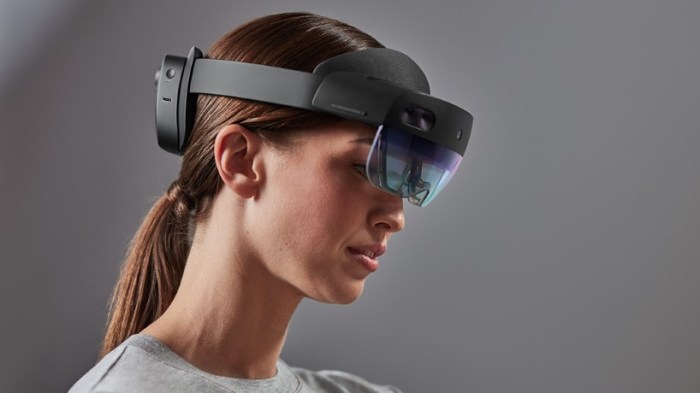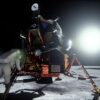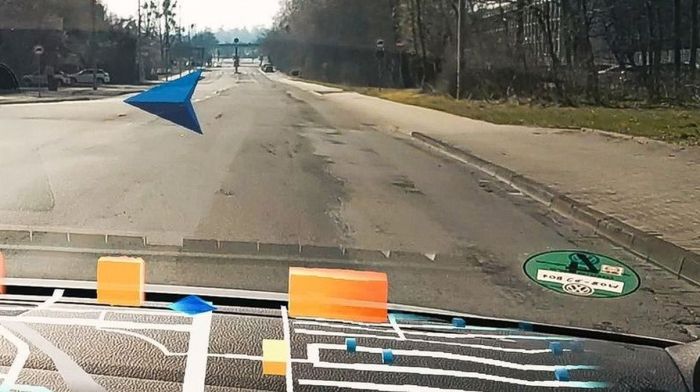Microsoft tests its HoloLens 2 AR headset in cars with Volkswagen, setting the stage for a fascinating exploration of augmented reality in the automotive industry. This collaboration promises to revolutionize the driving experience, potentially integrating augmented navigation, maintenance assistance, and enhanced infotainment features into the vehicle.
The project delves into the technical integration, user experience, safety considerations, and potential market impact of this innovative technology. We’ll explore how the HoloLens 2 functions within the car’s environment, and examine the potential benefits and challenges for both drivers and manufacturers.
Introduction to the Collaboration

Microsoft’s testing of its HoloLens 2 augmented reality (AR) headset in Volkswagen vehicles marks a significant step towards integrating cutting-edge technology into the automotive industry. This collaboration between a leading tech company and a major automaker signals a potential paradigm shift in how we interact with our cars, promising to enhance both driver experience and safety. The testing phase provides valuable insights into the practical application of AR in vehicles, paving the way for future developments.This partnership is crucial because it explores the feasibility of AR overlays in real-world driving scenarios.
AR technology offers the potential to revolutionize the automotive experience, augmenting traditional interfaces with digital information, and improving safety and efficiency.
Potential Benefits of AR Integration
Integrating AR technology into vehicles offers several potential advantages. Enhanced driver awareness and improved safety are top priorities. Imagine overlaying crucial driving information directly onto the driver’s field of vision, reducing the need to look away from the road. Navigation instructions, traffic alerts, and even maintenance reminders could be presented in a clear and concise manner. This hands-free approach to information access is expected to significantly reduce driver distraction and improve overall safety.
Furthermore, AR could revolutionize the way vehicles are used and maintained. Interactive service manuals and repair guides could be projected onto the windshield, guiding technicians through complex procedures and reducing downtime.
Potential Drawbacks and Challenges
Despite the potential benefits, there are also potential drawbacks to consider. One key concern is the potential for distraction, particularly if the AR overlays are not designed carefully. Poorly designed displays could lead to visual overload and negatively impact driver focus. The reliability and robustness of the technology in diverse weather conditions and lighting environments must be meticulously evaluated.
Furthermore, the cost of integrating AR technology into vehicles needs to be considered. The initial cost for consumers may be a significant barrier to widespread adoption.
Impact on Driver Experience and Safety
The impact of AR on driver experience and safety is multifaceted. A well-designed AR system can transform the driver’s experience by providing a seamless and intuitive way to access crucial information. The ability to see navigation instructions and safety warnings directly in the driver’s field of vision, without requiring them to look away from the road, is expected to significantly improve safety.
Furthermore, the use of AR for maintenance and service could streamline repairs and reduce downtime. However, the system’s effectiveness in varying weather conditions, especially in low-light situations, needs further evaluation. The potential for distraction from poorly designed AR interfaces is also a significant concern.
Technical Aspects of the Integration
Microsoft’s HoloLens 2, partnered with Volkswagen, is pushing the boundaries of augmented reality (AR) in the automotive industry. This collaboration signifies a significant step towards integrating immersive technologies into everyday driving experiences. The testing phase focuses on practical applications, examining how AR can enhance driver safety, improve vehicle maintenance, and potentially redefine the in-car user experience.The core goal of this integration is to create a seamless bridge between the digital and physical realms within the car.
Microsoft’s testing of the HoloLens 2 AR headset in Volkswagens is pretty cool, but it got me thinking about the future of augmented reality in cars. It’s all about seamless integration, and that reminds me of a fascinating interview I read recently, “the brutalist brady corbet director interview” the brutalist brady corbet director interview. Hopefully, this kind of innovative tech will lead to a future where augmented reality in cars is as intuitive and useful as, well, a car itself.
This involves carefully considering the technical intricacies of the hardware and software components, along with the user interface and communication protocols. The testing process ensures the technology can operate reliably and safely under diverse driving conditions.
HoloLens 2 Functionalities in Vehicles
The HoloLens 2, with its advanced spatial computing capabilities, can overlay digital information directly onto the driver’s field of view. This translates to a variety of potential functionalities. Projected information can range from real-time navigation instructions and traffic updates to interactive vehicle diagnostics and maintenance guides. For instance, the headset could highlight potential maintenance issues by overlaying 3D models of engine components onto the actual engine.
Hardware and Software Components
The integration requires a precise interplay of hardware and software components. The HoloLens 2, with its high-resolution display and sophisticated sensors, is the central component. Crucially, the headset must be securely mounted within the vehicle, ensuring stability and preventing interference with the driver’s field of view. The car’s onboard computer system is critical for providing real-time data and communicating with the HoloLens 2.
This system will be equipped with sensors, processors, and the necessary software to handle the data transmission and processing required by the AR application. Custom software will be needed to bridge the gap between the HoloLens 2 and the car’s systems. Specific algorithms will be required for real-time processing and display of the data on the headset’s display.
User Interface Design for Interaction
The user interface (UI) design for interacting with the HoloLens 2 in a vehicle must be intuitive and driver-focused. The overlayed information must be clear, concise, and easily navigable. Gestures, voice commands, or a combination of both would likely be used for interaction. The UI would need to adapt to the driver’s current situation and ensure that critical information is readily available without distracting the driver from the road.
A primary concern is ensuring the visual cues do not cause any form of visual impairment or discomfort for the driver.
Data Transmission Protocols
Efficient and reliable data transmission is crucial for the seamless operation of the AR system. The specific protocols used for communication between the HoloLens 2 and the car’s systems are not publicly available. However, we can expect secure, high-bandwidth protocols to ensure the rapid exchange of data without delays or errors. A robust system for handling network congestion and latency is also important.
Furthermore, the data transmitted must be secure and encrypted to prevent unauthorized access.
Potential Applications and Use Cases
The integration of HoloLens 2 augmented reality (AR) headsets into vehicles like the Volkswagen models presents a wealth of opportunities to enhance the driving experience beyond traditional navigation systems. This technology promises to revolutionize how we interact with our cars, offering a more intuitive and safer driving environment. The possibilities extend from improved maintenance procedures to a completely reimagined in-car entertainment system.The HoloLens 2, with its spatial computing capabilities, can overlay digital information directly onto the driver’s field of vision, reducing distractions and improving situational awareness.
This augmented reality interface has the potential to significantly improve the safety and efficiency of driving, especially in complex situations or when performing maintenance tasks.
Augmented Navigation and Guidance
The driver’s experience can be significantly enhanced with augmented navigation. Instead of just relying on a screen, the HoloLens 2 can project turn-by-turn directions directly into the driver’s line of sight, overlaid on the real-world view. This reduces visual scanning, which can decrease driver fatigue and improve safety. Furthermore, the system can provide real-time traffic updates, highlighting potential delays and alternate routes, using holographic representations.
This augmented navigation system will improve driver efficiency and reduce travel time.
Maintenance and Repair Assistance
HoloLens 2 can provide real-time maintenance support. Complex tasks like checking tire pressure, inspecting engine components, or even performing basic repairs can be greatly simplified by projecting step-by-step instructions and diagrams directly onto the vehicle’s components. The system could also overlay schematics of the vehicle’s undercarriage or engine, providing a detailed view of the mechanics. This augmented reality assistance can improve the accuracy and speed of maintenance tasks, allowing for quicker and more efficient service.
Enhanced In-Car Infotainment
The integration of HoloLens 2 opens new horizons for in-car entertainment and infotainment. Imagine holographic displays of personalized music playlists, interactive maps with 3D city models, or even projected games overlaid on the dashboard or windshield. This immersive experience can transform the car into a dynamic and engaging environment, making long drives more enjoyable. Furthermore, holographic overlays of personalized news feeds or social media updates can keep the driver informed without taking their eyes off the road.
Microsoft’s testing of the HoloLens 2 AR headset in Volkswagens is pretty cool, isn’t it? It’s fascinating to see how tech is merging with the automotive world. Speaking of interesting developments, have you heard about Barack Obama praising Michelle’s portrait as a sign of her well-being? barack obama hails michelles portrait as it shows that shes fine.
Regardless, this whole HoloLens 2 integration with cars feels like a massive leap forward in the future of driving. Hopefully, it won’t be too long before we’re seeing these kinds of advancements become mainstream.
Safety Enhancements
The use of HoloLens 2 can improve driver safety in a number of ways. The system could project warnings about potential hazards, such as upcoming traffic incidents or road closures, in the driver’s field of view. This proactive approach can prevent accidents by providing early warning systems. Similarly, the system could highlight potential blind spots or nearby vehicles, enhancing awareness and situational understanding.
By creating a safer and more intuitive environment, the technology will directly reduce accident rates.
User Experience and Interface Design

The integration of augmented reality (AR) into automobiles, like the HoloLens 2 in Volkswagen vehicles, demands meticulous attention to user experience. A seamless and intuitive interface is crucial for driver safety and efficiency. This necessitates careful consideration of the visual presentation, control methods, and overall interaction with the AR overlays. The goal is to ensure the AR system enhances the driving experience, not detracts from it.
Driver-Centric Design Considerations
The design of the AR interface must prioritize the driver’s needs. This involves minimizing distractions and ensuring critical information is presented clearly and unobtrusively. The system should adapt to the driver’s visual habits and preferences. Complex data should be simplified and presented in a clear, concise manner, preventing cognitive overload. For example, instead of overwhelming the driver with a dense map overlay, the system should focus on highlighting relevant information, such as upcoming turns or navigation instructions, within the car’s immediate surroundings.
Intuitive Controls and Navigation
Providing intuitive controls is paramount. The driver should be able to interact with the AR interface without taking their hands off the wheel or their eyes off the road. Voice commands, haptic feedback, and strategically placed buttons on the dashboard can all contribute to a seamless interaction. A simple and straightforward control scheme is vital for safety and efficiency.
For instance, voice commands for navigation, lane changes, and adjustments to the display should be clearly audible and responsive. Haptic feedback can confirm commands and highlight critical information.
Visual Presentation and Clarity
The visual presentation of AR information is critical. Information should be presented in a way that complements the driver’s existing visual cues and does not obscure important visual data. Transparency and visual depth cues should be used effectively to separate AR overlays from the real-world environment. For example, overlays should be presented with a semi-transparent quality, blending seamlessly with the car’s interior, making them easy to interpret without drawing excessive attention.
Colors and textures should be used strategically to highlight important information and guide the driver’s eye to the correct data.
Comparison with Existing Systems
Comparing the user experience of the HoloLens 2 AR system with others reveals valuable insights. Early AR navigation systems often suffered from poor integration, cluttering the driver’s field of view with distracting overlays. Systems that rely on head-mounted displays (HMDs) may have issues with user comfort and potential disorientation. By comparison, the Volkswagen integration using the HoloLens 2 appears to place a strong emphasis on integrating seamlessly with the car’s existing interface, reducing these potential problems.
Effective Display Examples, Microsoft tests its hololens 2 ar headset in cars with volkswagen
To illustrate the potential of effective AR display, consider a scenario where navigation instructions are overlaid onto the windshield. A clear arrow, representing the next turn, could appear directly in front of the driver’s view. Additional information, such as the distance to the turn and any traffic warnings, could be displayed in a simplified format near the arrow.
Similarly, maintenance alerts could be presented as holograms projected onto the dashboard or directly into the driver’s line of sight, without requiring a significant visual shift.
Safety and Regulatory Considerations
Integrating augmented reality (AR) headsets like the HoloLens 2 into vehicles presents a complex interplay of safety and regulatory challenges. While the potential benefits for improved driver assistance and enhanced situational awareness are substantial, the potential for distraction and user error must be carefully addressed. A robust safety framework is crucial to ensure safe operation and compliance with existing and evolving regulations.The integration of AR technology in vehicles requires a thorough evaluation of its impact on driver safety, considering the cognitive load imposed on the driver and the potential for interaction errors.
This evaluation must take into account the nuances of driver behavior, varying driving conditions, and the specific design of the AR interface.
Safety Implications of AR Headsets in Driving
The primary safety concern revolves around the potential for distraction. AR displays, while designed to overlay information onto the driver’s field of view, can divert attention from essential driving tasks. This distraction can manifest in various forms, from briefly glancing at the display to prolonged engagement with AR features. The crucial factor is the duration and nature of this interaction and how it is designed into the user interface.
Potential for Distraction and Interface Design
Effective user interface design is paramount to mitigate distraction risks. The AR system must prioritize essential driving information and minimize the need for the driver to interact with the AR interface while the vehicle is in motion. Visual cues and haptic feedback can be employed to alert the driver to important information without requiring visual fixation on the display.
For example, a subtle vibration in the steering wheel could alert the driver to a potential hazard detected by the system, directing their attention without forcing them to take their eyes off the road. The design should be intuitive and consistent with established driving conventions, minimizing cognitive load and ensuring seamless integration with the driver’s existing workflow.
Regulatory Hurdles
The integration of AR technology into automobiles faces significant regulatory hurdles. Existing regulations for vehicle safety and driver behavior often lack specific provisions for AR systems. This necessitates collaboration between automotive manufacturers, technology providers, and regulatory bodies to develop clear guidelines and standards for safe implementation. Existing regulations on driver distraction and vehicle safety must be adapted and expanded to include AR systems.
Ensuring Safe Operation with HoloLens 2 in Cars
Safe operation of the HoloLens 2 in cars necessitates a multi-faceted approach. This includes rigorous testing and validation of the system under various driving conditions, incorporating real-world scenarios and potential user errors.
- Driver Training: Comprehensive driver training programs are essential to familiarize drivers with the system’s capabilities and limitations. Training should emphasize safe operation procedures, highlighting the potential for distraction and the importance of maintaining situational awareness.
- System Limitations: Clear limitations of the system should be communicated to the driver through intuitive interfaces and visual cues. The system should be designed to gracefully handle situations where it cannot provide accurate or helpful information.
- Redundancy and Fail-safes: The system should incorporate redundancy and fail-safe mechanisms to prevent critical failures and ensure a fallback to traditional driving controls.
- Continuous Monitoring and Feedback: Continuous monitoring of driver behavior and system performance is essential to identify potential issues and adapt the system accordingly. User feedback mechanisms should be incorporated to improve the user experience and ensure system safety.
Market Analysis and Competitive Landscape
The automotive industry is undergoing a significant transformation, with augmented reality (AR) poised to play a crucial role in shaping the future of driving experiences. Microsoft’s HoloLens 2 integration with Volkswagen’s vehicles represents a substantial step towards realizing this potential. Analyzing the current market and competitive landscape is critical to understanding the opportunities and challenges ahead.The potential market for AR in automobiles is vast, spanning from driver assistance features to enhanced in-cabin experiences.
Early adoption by luxury brands and tech-savvy consumers suggests a high demand for innovative and intuitive AR applications. However, widespread market penetration hinges on the development of compelling use cases and addressing potential concerns about safety and user experience.
Potential Market for AR in Automotive
The automotive market is a significant target for AR technology. Drivers and passengers alike can benefit from enhanced safety features, interactive infotainment, and more immersive in-car experiences. The market’s size and growth potential are directly linked to the acceptance of AR technology in daily life. The demand for advanced driver-assistance systems (ADAS) and in-cabin entertainment options fuels the market growth.
Comparison of Microsoft’s Approach with Competitors
Microsoft’s approach to integrating AR into automobiles centers around the HoloLens 2 headset, emphasizing a spatial computing experience. Other companies, like Google and Apple, are also exploring AR in the automotive sector. Google’s focus on augmented overlays and infotainment systems contrasts with Microsoft’s more comprehensive spatial computing strategy. Apple’s strategy, while less publicly disclosed, is likely to focus on seamless integration with existing Apple ecosystems.
Each approach has its own strengths and weaknesses, depending on the intended application and user experience.
Expected Competitive Landscape for AR in Automotive
The competitive landscape for AR in the automotive sector will be highly dynamic. Multiple players, including established automakers, technology companies, and specialized AR developers, will compete for market share. Competition will revolve around innovation in hardware, software, and user experience. Key differentiators will likely include the sophistication of the AR interface, the breadth of available applications, and the level of safety and reliability.
Microsoft’s testing of the HoloLens 2 AR headset in Volkswagen cars is fascinating, but it makes me think about the broader implications of technology. Imagine the potential for these advancements in policing, where body cameras and the ability to record interactions in real time could help address issues like police brutality. The consequences of such technology, particularly in relation to the Black Lives Matter movement and the importance of video evidence in these cases, are significant.
This discussion highlights the ethical considerations, ultimately impacting how we use these powerful tools. Still, the integration of AR technology in cars like the ones from Volkswagen remains an exciting area of development.
This will lead to a race to deliver cutting-edge solutions.
Potential Roadmap for Future Developments
The future of AR in automobiles is likely to involve a phased rollout, starting with limited functionalities in high-end vehicles. A clear roadmap for future development is essential to manage expectations and guide the industry’s progress. Initial use cases will likely focus on navigation, vehicle diagnostics, and enhanced infotainment. As technology matures and user experience improves, more complex applications, such as augmented reality maintenance and repair guides, will emerge.
This evolutionary approach will allow for iterative improvements and continuous refinement.
Visual Representation of Data and Information
The HoloLens 2, integrated into a vehicle like the Volkswagen, offers a unique opportunity to revolutionize the driver’s experience. Effective data visualization is crucial for this AR system to be truly beneficial. By overlaying relevant information directly onto the driver’s field of vision, the system can enhance awareness, reduce cognitive load, and potentially prevent accidents.
Data Overlay Types
Visualizing data in a clear and intuitive way is paramount for driver safety and efficiency. Different types of data require different display methods to be most effective. This section details how various data types can be visually presented to the driver in an intuitive and easily understandable way.
| Data Type | Display Method | User Interface Elements | Potential Benefits |
|---|---|---|---|
| Navigation | Holographic Projections | Voice Commands, Gesture Controls, Interactive Map Overlay | Improved route awareness, Reduced cognitive load by offloading navigation instructions from the driver’s mind. |
| Speed | Text Overlay | Dynamic Speed Display, Customizable Font/Size | Instantaneous speed feedback, allowing the driver to maintain optimal speed within the driving limits. |
| Traffic Alerts | 3D Models and/or Animated Arrows | Haptic Feedback, Audible Warnings, Proximity/Distance Indicators | Enhanced awareness of potential hazards, timely warnings of traffic conditions, minimizing delays. |
| Road Conditions | Holographic Overlay | Color-Coded Visualization, Icons for Potholes/Construction, Overlayed on road surfaces. | Increased driver awareness of the road ahead, enabling proactive decision-making in case of hazardous conditions. |
| Hazard Warnings | High-Contrast Visual Alerts, Flashing Lights | Audible Warnings, Vibration Feedback | Immediate awareness of danger and potential hazards, ensuring timely reaction. |
Intuitive Presentation Examples
To illustrate the effectiveness of different data visualization methods, consider these examples. Navigation instructions could be projected as holographic arrows or 3D models that dynamically guide the driver to their destination, overlaid on the road ahead. Real-time speed information could be presented as a clear, easily readable text overlay, positioned within the driver’s field of view. Traffic alerts could be displayed as animated arrows or icons, clearly indicating congestion or road closures.
These elements, presented in an easily readable format, can effectively support the driver.
Future Implications and Possibilities
The collaboration between Microsoft and Volkswagen on integrating HoloLens 2 AR technology into automobiles signifies a significant step toward the future of the automotive industry. This marks a transition from traditional interfaces to interactive, augmented realities, prompting a fundamental shift in how we interact with vehicles and the world around them. Beyond the automotive sector, the implications of AR technology are profound and widespread, promising to revolutionize various aspects of daily life.
Transformation of the Automotive Industry
The integration of AR in vehicles is not merely an upgrade; it represents a paradigm shift. Imagine a future where drivers receive real-time traffic updates projected onto their windshield, or maintenance alerts displayed directly in their field of vision. Navigation systems can become more intuitive, with augmented directions guiding drivers effortlessly through complex intersections or unfamiliar cities. This enhanced interactivity leads to safer driving, more efficient navigation, and a significantly improved user experience.
Furthermore, the ability to visualize vehicle maintenance needs in real-time will streamline repairs and reduce downtime.
Broader Implications of AR Technology
The impact of AR technology extends far beyond the automotive realm. Its applications are diverse, ranging from educational tools to medical advancements. In healthcare, surgeons can use AR overlays to enhance surgical precision, while educators can utilize AR to bring complex concepts to life in classrooms.
Potential Future Applications of AR Technology
The possibilities are virtually limitless. AR can revolutionize industrial training by providing hands-on, interactive tutorials that guide workers through complex procedures. Imagine a scenario where a technician can view detailed schematics and step-by-step instructions overlaid on their view of a piece of equipment, allowing for precise and error-free repairs. Furthermore, AR could significantly enhance e-commerce, allowing customers to visualize products in their own homes before purchasing.
Imagine trying on clothes or furniture virtually through an AR app, transforming online shopping into a more immersive and engaging experience.
Impact on Human-Technology Interaction
AR is poised to fundamentally change how we interact with technology. It’s moving beyond touchscreens and keyboards, replacing them with intuitive, natural interfaces. This shift towards a more human-centric approach to technology will lead to greater efficiency and user satisfaction in all aspects of our lives. By overlaying information onto the real world, AR creates a seamless integration between the digital and physical spheres.
This merging of the two worlds promises a future where technology enhances our lives without intruding upon our natural surroundings.
Last Point: Microsoft Tests Its Hololens 2 Ar Headset In Cars With Volkswagen
Microsoft’s partnership with Volkswagen marks a significant step towards integrating AR technology into everyday vehicles. The potential for enhanced driver experience, improved safety, and a more engaging in-car experience is undeniable. However, navigating the regulatory landscape and addressing user experience challenges will be crucial to the successful implementation of this innovative technology.





